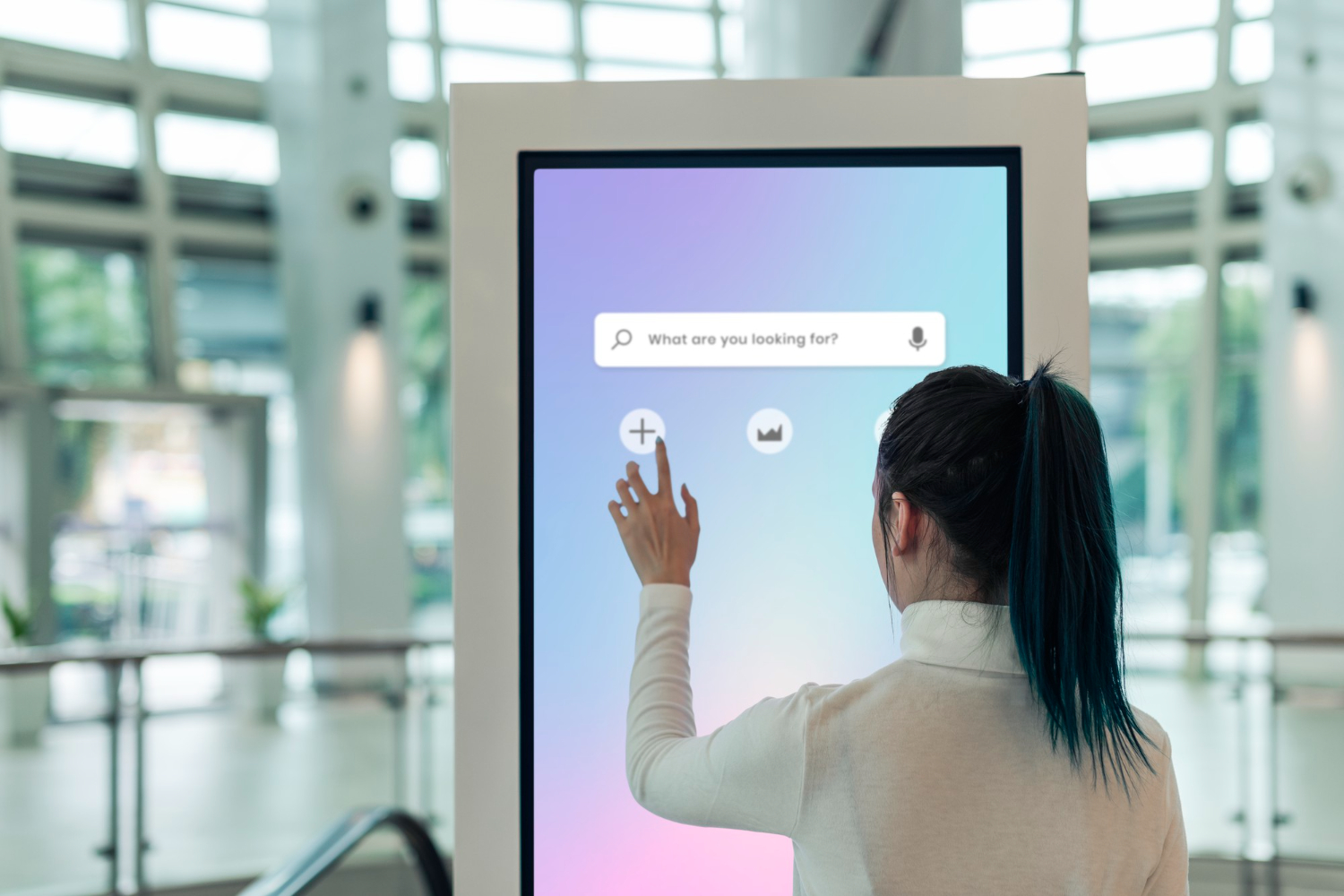Text to Speech in Interactive Kiosks: A Game-Changer for Retail

As we traverse the lively terrain of today's retail industry, interactive kiosks stand out as game-changing innovations. Seamlessly knitting together the digital threads of convenience and the physical allure of in-store shopping, these kiosks blend two distinct worlds into a harmonious symphony of consumer experience. By acting as the much-needed bridge, they are instrumental in forging a delightful balance between online convenience and the tactile allure of brick-and-mortar stores.
In this confluence of technology and commerce, the possibilities for innovation are practically infinite. One such breakthrough making a marked difference is the integration of text to speech (TTS) technology in interactive kiosks.

Table of Contents
Role and Benefits of TTS in Interactive Kiosks
The role of text to speech technology in interactive kiosks has significantly transformed the kiosk experience. It not only enhances accessibility for individuals with disabilities but also facilitates multilingual support, provides user guidance, enables real-time updates, and contributes to more engaging user experiences. Let's delve deeper into the manifold benefits of integrating TTS technology into interactive kiosks.
Enhancing Customer Experience
TTS technology heightens the customer experience by making it more immersive and engaging. Imagine walking up to a kiosk, and instead of trying to navigate through a maze of text and images, you're greeted by a friendly voice guiding you through your journey. The auditory assistance offered by text to speech eases the process of understanding instructions, provides real-time assistance, reduces errors, and ultimately leads to an enhanced customer experience.
Increasing Accessibility
Interactive kiosks embedded with TTS create an inclusive environment that appeals to a broader demographic. They play a crucial role in making technology accessible to those with visual impairments or reading difficulties. By translating visual information into spoken words, these kiosks allow individuals who might struggle with traditional interfaces to access services with ease.
Personalization and Customization
Interactive kiosks with TTS capabilities offer opportunities for personalization and customization like never before. A kiosk that "speaks" to customers can deliver personalized pre-recorded messages based on their preferences, making them feel valued and understood. By customizing these interactions, businesses can build stronger relationships with their customers, enhancing loyalty and satisfaction.
Driving Sales and Conversion
Implementing TTS in interactive kiosks isn't just about enhancing user experience or accessibility; it's also a potent tool for driving sales. The ease and simplicity that TTS brings can prompt users to spend more time interacting with the kiosk. This increased engagement can result in higher sales, as customers who enjoy the shopping process are more likely to make a purchase.
Best Practices for Implementing Text to Speech in Retail
Successfully implementing text to speech technology in interactive kiosks requires careful consideration and planning. It's not just about selecting a TTS solution but also about understanding the nuances that make for an effective and engaging auditory user experience. Here are some best practices to follow when integrating text to speech into your interactive kiosks.
Choosing the Right Text to Speech Solution
The choice of TTS solution lays the foundation for the overall user experience. The selected software should offer a wide range of voices and languages, demonstrate adaptability to different applications, and ensure robust performance. Scalability and integration with existing systems are also critical factors to consider. The right solution will be able to grow with your business, meeting the evolving demands of your customers and the market.
Considering Linguistic and Cultural Factors
Catering to your customers linguistic and cultural needs is a critical aspect of user engagement. The TTS solution you choose should be able to support a wide array of languages and accents, reflecting the diversity of your customers. It should also take into account cultural nuances in pronunciation and intonation, ensuring that the speech output is accurate and understandable to all users.
Ensuring Clear and Natural Sounding Voice
Clarity and naturalness are the hallmarks of an effective text to speech system. The voice output should be clear, with proper enunciation and sound rhythm, making it easy for users to comprehend the spoken information. A robotic or monotonous voice can be off-putting to users, reducing engagement and effectiveness.
Customizing Voice for Brand Identity
The voice of your kiosk can serve as a reflection of your brand identity. With the right TTS solution, you can customize the voice output to align with your brand persona, whether friendly, casual, formal, or professional. This helps create a cohesive brand experience across all touchpoints, enhancing brand recall and loyalty.
Overcoming Challenges and Limitations
While TTS technology offers many advantages, there may also be challenges and limitations to overcome. These can range from technical glitches and pronunciation inaccuracies to privacy concerns in a public setting. Planning for these potential issues, and having strategies in place to mitigate them, can ensure a smoother and more positive user experience.
Also Read : Text to Speech for Animators: Enhancing Creative Possibilities
Top Text to Speech Solutions for Interactive Kiosk
In the bustling world of text to speech solutions, a diverse spectrum of platforms exists, each with its unique strengths and features that can greatly enhance the efficacy of your interactive kiosks. Here are some of the premier TTS technologies making a notable impact on the market.
Murf
Emerging as a powerful force in the text to speech field, Murf distinguishes itself with its extraordinary capacity for voice customization. The voice generation tool cleverly integrates AI to achieve voice cloning, creating impressively authentic voices. Murf even brings a melodic twist by enabling users to couple music with its diverse voice selection. The result is an unparalleled opportunity for businesses to curate a unique auditory brand persona, ensuring they leave a memorable mark on their target audience when interacting with kiosks.
Speechify
Standing proud in the TTS market, Speechify AI differentiates itself by offering excellent voice output quality while maintaining user-friendly interfaces. Its distinctive design, aimed at aiding individuals with reading difficulties, places Speechify at the forefront of accessibility, promising a seamless interactive kiosk experience for all users.
WellSaid Labs
Carving out a niche for itself, WellSaid Labs impresses with its revolutionary synthetic voices devoid of any background noise. These synthetic voices enable businesses to construct highly individualized auditory experiences, catapulting customer-kiosk interaction to unprecedented heights.
Natural Reader
In keeping with its name, Natural Reader emphasizes providing natural-sounding voices. Its hallmark lies in the simplicity of its use and its expansive selection of voices, accents, and styles. This focus enables businesses to effectively cater to a broad spectrum of customers, enhancing the universality of their interactive kiosks.
Amazon Polly
With its extensive toolbox, Amazon Polly stands out as an excellent choice for multinational enterprises. Its key features include support for real-time audio streaming and an array of languages. This robust offering ensures a culturally and linguistically diverse experience for kiosk users worldwide.
FakeYou
Leveraging the might of AI, FakeYou excels in generating voices and phrases that mirror natural human speech closely. Its capacity to replicate the subtleties of human speech empowers businesses to craft engaging and personalized user interactions at their kiosks, leaving an enduring impression on their customers.
TTSReader
TTSReader sets itself apart with its adaptability and support for various languages and accents. Its flexible nature equips businesses to broaden their reach, effortlessly engaging with audiences from multiple cultural and linguistic backgrounds through their interactive kiosks.
Why Murf is the Best Text to Speech Software?
Murf empowers businesses to provide customers with a seamless and personalized auditory experience, setting it apart from other TTS platforms. Murf offers several compelling advantages for those looking to integrate TTS technology into their retail kiosks.
The strength of Murf lies in its voice customization options. It allows businesses to create a distinctive voice that is intended to perfectly embody their brand, ensuring a cohesive and memorable brand experience. The customized voice command output can cater to a diverse customer base, recognizing and respecting their unique needs and preferences.
Murf's voice cloning capability is another significant feature. This technology enables businesses to clone a specific voice, allowing for consistent and recognizable voice output without any ambient noise across all interactive kiosks to be launched remotely. The familiarity of the voice adds a personal touch, making customers feel more connected and engaged. Whether you're serving a local audience or an international clientele, Murf's extensive voice library of 120+ AI voices across 20+ global languages and accents can cater to different languages and dialects, enhancing accessibility and user experience.
Harnessing the Power of Voice Technology: The Future of Retail
As we traverse the path toward a more digital and interactive future in retail, it is evident that text to speech is not merely a shiny new gimmick. It is a crucial cog in the wheel that drives customer engagement, fosters inclusivity, and boosts sales. The innovative amalgamation of interactive kiosks and TTS promises to reshape the retail landscape, offering a more immersive and personalized shopping experience.
Strategic implementation of TTS in kiosks is crucial, and choosing the right TTS solution like Murf is pivotal in this journey. As we stand on the cusp of this exciting new era, the retail industry must leverage these technological advancements to enhance customer experiences, paving the way for a more inclusive, engaging, and profitable future.

FAQs
How does text to speech technology benefit customers with visual impairments?
Text to speech technology significantly enhances the retail experience for customers with visual impairments. By converting visual data into spoken words and commands, it enables these customers to interact with retail kiosks independently. They can receive important information, pre-programmed navigation options, and make purchases without the need for external assistance.
How can retailers ensure accurate pronunciation of product names with text to speech?
Ensuring accurate pronunciation of product names with TTS can be achieved through careful configuration and customization. For example, high-quality TTS solutions like Murf offer the ability to adjust pronunciation settings or even customize the pronunciation and fine-tune the speech output.
What challenges should retailers consider when implementing text to speech?
While TTS technology offers immense benefits, retailers should also be aware of potential challenges. These could include ensuring the naturalness of the speech output, as robotic or monotonous voices can deter customer engagement. Technical issues, such as system integrations and compatibility, need to be addressed. Retailers should also consider cultural and linguistic variations among their customers, ensuring the TTS solution caters to various accents and languages. Privacy concern, especially in a public setting where personal information may be spoken out loud, is another factor to be considered.



